![]()
![]()
![]()
Use LEFT and RIGHT arrow keys to navigate between flashcards;
Use UP and DOWN arrow keys to flip the card;
H to show hint;
A reads text to speech;
139 Cards in this Set
- Front
- Back
|
What is the configuration for an inverting amp? |
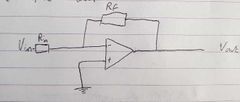
|
|
|
What is the gain of an inverting amp? |
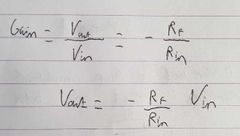
|
|
|
What is the configuration for a summing amp? |
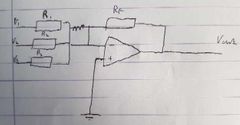
|
|
|
What is V out of a summing amp if all of the input resistors different? |

|
|
|
What is V out of a summing amp if the input resistors r the same? |

|
|
|
What is the configuration for a non-inverting amp? |

|
|
|
What is the gain for a non-inverting amp? |

|
|
|
What is the configuration for a differential amp? |
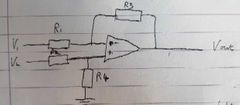
|
|
|
What's the equation for V out of a differential amp? |
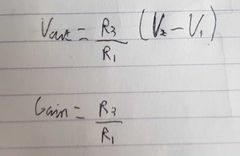
|
|
|
What is the configuration for a voltage to current converter op-amp? |

|
|
|
What is the configuration for a current to voltage converter op-amp? |

|
|
|
What are input bias currents? |
The current which flow into the inputs of an op-amp |
|
|
What is the offset current? |
The difference between inverting and non-inverting bias currents |
|
|
Why can bias currents be a problem? |
Because they can produce a voltage across the input impedance which can cause an error in your output voltage |
|
|
How can bias currents be eliminated? |
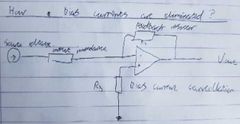
R3 is the value of R1+R2 in parallel this makes the voltages created on both inputs the same which eliminates the output errors |
|
|
What is the unity gain bandwidth of an op-amp? |
The range of frequencies in which an op-amp can produce a gain |
|
|
What is the full power bandwidth? |
The range of frequencies where the gain of an op-amp is at its maximum |
|
|
What is the transition frequency? |
The point where no gain is produced |
|
|
What is slew rate? |
The maximum rate at which an op-amp can change its output |
|
|
What are the pins of a op-amp? |

|
|
|
What are the idea characteristics of an op-amp? |
1. Infinite input impedance 2. Zero output impedance 3.infinite bandwidth 4.Infinite open loop gain 5. Infinite slewrate 6. Infinite common mode rejection ratio |
|
|
Why does the input impedance need to be infinite? |
So that the input applied between the terminals will get directly applied to the op-amp |
|
|
Why does there need to be zero output impedance? |
So that the op-amp can apply all of its output voltage directly to the load |
|
|
Why does the bandwidth need to be infinite? |
So that it can produce a gain at all frequencies |
|
|
Why does open loop gain need to be infinite? |
So that when V in equal 0, V out equals 0 |
|
|
Why does the slewrate need to be infinite? |
So that the output can go from 0V to max voltage instantly |
|
|
What is the common mode configuration? |

|
|
|
What is the ideal scenario in the common mode configuration? |
For V out to equal 0 |
|
|
What is the equation for the common mode rejection ratio? |
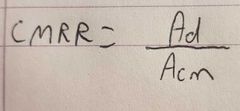
|
|
|
What is the differential configuration and how is V out calculated from it? |

|
|
|
What is a sample and hold circuit used for? |
To give the ADC time to convert an analogue signal into a digital signal |
|
|
What is the configuration of a sample and hold circuit? |
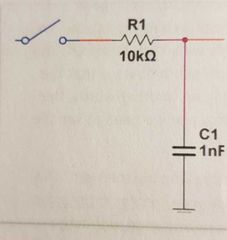
|
|
|
How does a sample and hold circuit work? |
When the switch closes, the capacitor charges, when the switch opens the capacitor holds its charge which holds the signal |
|
|
What is the maximum time the capacity can take to charge? |
1/sample frequency |
|
|
What is V out equal to in a sample and hold circuit? |
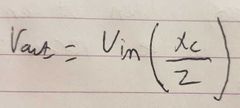
|
|
|
What is the impedance equal to in a sample and hold circuit? |

|
|
|
What does Nyquist's sampling theorem state? |
That the sampling rate must be greater than twice the highest frequency present in the signal being sampled |
|
|
What does shannon's sampling theorem state? |
A signal can be reconstructed from its samples if the original signal has no frequencies above half the sampling frequency |
|
|
What is aliasing? |
When you create a lower frequency signal from a higher frequency sign |
|
|
What is the recommended sample rate in industry? |
5 to 10 times the original frequency |
|
|
If the bandwidth increases what impact can it have on sampling? |
It can cause a false lower frequency signal to be reconstructed by the sample and hold circuit? |
|
|
How is aliasing prevented? |
By using a low pass filter (Anti-Aliasing filter) to limit the input signal to half of the sampling frequency |
|
|
What is the configuration for a buffer amp? |
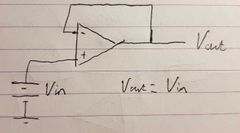
|
|
|
What is a buffer amp used for? |
To isolate 2 circuits. It also guarantees that the output if one circuit will appear as the input of another circuit. Finally it removes the loading effect between two circuits |
|
|
What is the formula for CMRR in dB? |

|
|
|
What is the configuration for a instrumention amplifier? |
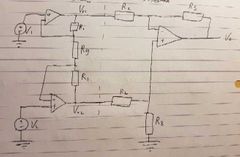
|
|
|
What are the formulas for gain and output voltage of an instrumentation amplifier? |
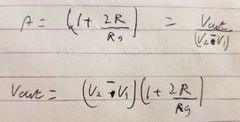
|
|
|
What are the advantages of an instrumentation amplifier? |
1. High input impedance from V1 and V2 2. You can adjust the gain by only using one resistor which u can't do by just using a differential op-amp since you need the impedance to match on both inputs to the op amp. If they don't this can distort the output |
|
|
What do decibels describe? |
The gain of a system |
|
|
What are the equations for the gain of a system in dB? |

|
|
|
What is the cut off frequency? |
The frequency at which the energy going through a system begins to be reduced rather than passing through |
|
|
What is the equation for the cut off frequency? |

|
|
|
What is the configuration for an inverting low-pass filter? |
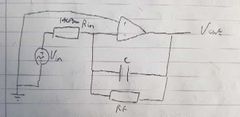
|
|
|
How does an inverting low-pass filter work? |
As the frequency increases the impedance of the capacitor decreases. This makes the impedance of the parallel pair lower which makes the gain of the amplifier lower since gain equals Rf/Rin. This blocks higher frequencies from coming through |
|
|
What is the configuration for an inverting high pass filter? |

|
|
|
How does a high pass filter work? |
At low frequencies the impedance of the capacitor is high. This makes the gain lower since A=-Rf/(Xc+Rin) which means that the lower frequencies don't get through |
|
|
What is a band pass filter made up of? |
A low and high pass filter where there's a capacity in series with Rin which determines the lowest frequency and there's another capacity in the parallel pair which determines the highest frequency |
|
|
What is random noise? |
A widespread random fluctuation in a signal which comes from all electrical components such as resistors. |
|
|
When is random noise a problem? |
High gain instrumention amplifiers |
|
|
What causes random noise? |
Poor connections and badly soldered joints |
|
|
What is impulsive noise? |
Noise which appear as random spikes on an otherwise steady signal |
|
|
What can cause impulsive noise? |
Switching of adjacent heavy or inductive loads m |
|
|
What is cross-coupled noise? |
Noise which appears as capacitive or inductive interference from power cables to adjacent signal cables |
|
|
What is a PLC |
A programmable logic controller is a digital computer used in industry |
|
|
What are the advantages of PLCs? |
1. Easy to program 2. East to maintain as parts can be replaced easily 3. Reliable 4. Easy to fault find on them 5. Very high accuracy 6. Smaller than other alternatives 7. Highly flexible 8. Can operate in harsh conditions |
|
|
What are the two main types of PLC? |
Modular and integrated |
|
|
What is an integrated PLC? |
It's a PLC which is built by several modules within a single case |
|
|
What is the advantage of integrated PLCs? |
They're smaller than other PLCs |
|
|
What is the disadvantage of integrated PLCs? |
The I/O capabilities are decided by the manufacturer instead of the user |
|
|
What is a modular PLC? |
A PLC which is built with several components that are plugged into a common rack with extendable I/O capabilities. These come in different sizes with variable power supply, computing capabilities and I/O connectivity |
|
|
What is a modular PLC made up of? |
1. A rack to insert modules 2 CPU module 3. Power supply modules 4. I/O modules |
|
|
What is the program scan cycle for a PLC? |
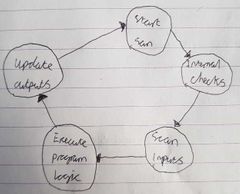
|
|
|
What happens for the internal checks? |
The PLC checks the I/O modules to see whether they're working correctly |
|
|
What happens in the scan inputs stage? |
The program reads the status of the inputs and places the data into the input table |
|
|
What happens in the program? |
The PlC scans the user memory to interpret the program. As the logic is solved rung by rung according to the status of the I/O table, the results from the program evaluation are stored in the output table and the storage but table |
|
|
What happens at the update outputs stage? |
The program updates the values stored on the output table and sends the commands to the output modules so that they can turn devices connected to the PLC on or off |
|
|
What does SCADA stand for? |
Supervisory Control And Data Aquisition |
|
|
What is SCADA |
A system of software and hardware elements |
|
|
What does SCADA allow organisations to do? |
1. Control industrial processes locally or at remote locations 2. Monitor, gather and process real time data 3. Directly interact with devices such as sensors, valves, pumps, motors, and more through human-machine interface (HMI) software 4. Record events into a log file |
|
|
What is the standard set up for a SCADA system? |

|
|
|
What are advantages of SCADA systems? |
1. Can store information which means that yo can wmfind out what has happened to a process in the past 2. You can try to improve a process's performance by looking back at data 3. Decrease downtime since it can tell you what has broken 4. Can display data in real time 5. Easy to add additional resources to the system |
|
|
What is the main property of sequential networks? |
The output depends not only on the present input but also on the past sequence of inputs |
|
|
What is a flip flop? |
A memory device which can assume one of two stable output states, which has a pair of complementary outputs and which has one or more inputs that can cause the outout state to change |
|
|
What is the initial configuration for a SR flip flop (when both inputs are 0)? |
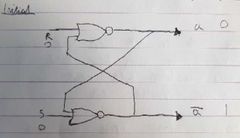
|
|
|
On a flip flop, if all inputs are 0, what happens? |
The output remains in its last recorded state |
|
|
Why is both inputs kn not allowed for a SR flip-flop? |
Because the flip-flop doesn't know what date to switch into which means that the out is unpredictable |
|
|
What does a trigger flip-flop do? |
It changes the state of the output if the trigger input changes m |
|
|
What is the configuration for a jk flip-flop? |
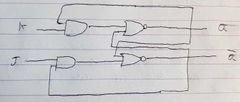
|
|
|
What is the advantage of a jk flip-flop over a SR flip-flop? |
Both inputs can be on at the same time |
|
|
What happens when both inputs of a JK flip-flop are on? |
It invests the output to its opposite state |
|
|
What are applications for a JK flip-flop? |
Registers and counters |
|
|
What is a ripple counter and how does it work? |
A ripple counter is an asynchronous counter made up of JK flip-flops. Only the first flip-flop is cloaked by an external cloak and all subsequent flip-flops are cloaked by the output of the preceding flip-flop. For example the first flip-flop switches on and off when the cloak has completed one time period (always changes state on the rising edge of the cloak waveform). The next flip flop then switches on and off after one time period of the first flip-flop. This gives flip-flops a time period of twice that of the cloak or previous flip-flop. In this configuration, J and K are constantly on in this state which means that the cloak is inverting the outputs of the flip-flops. The counter may count up or down depending on how the flip-flop is configured |
|
|
What is the difference between a ripple counter and a synchronous counter? |
The cloak inputs of all the flip-flops are cloaked at the same time by the same cloak signal? |
|
|
What is the main advantage of a synchronous counter over a ripple counter? |
It's faster because you don't get any delay from the transmission of pulses from flip-flop to flip-flop since they're all cloaked at the same time by the same signal |
|
|
How does a synchronous counter work? |
Only the first flip-flop is in toggle mode. From the first flip-flop, the Q output is connected directly to the JK inputs of the second flip-flop. The JK inputs of the other flip-flops are driven by AND gates which are supplied with signals from the previous flip-flops. This means that everytime the cloak changes the state of the first flip-flop, it also changes the state of the other flip-flops. If the Q outputs are connected to the AND gates, then the counter will count up, if they're connected to the other output, then the counter will count down |
|
|
What are the advantages of a ripple counter over a synchronous counter? |
Consumes less power and uses less components since they don't have to use AND gates |
|
|
What is a shift register and how does it work? |
A shift register is a type of sequential logic circuit that can be used for the storage or transfer of binary data. It loads the data present on its inputs and then moves it to its output every cloak cycle. It consists of several D-type data latches (one for each bit) connected together in a chain arrangement so that the output from one data latch becomes the input of the next one and so on. |
|
|
Where are shift registers used? |
In calculators and inside computers |
|
|
How can data into a shift register be inputed and outputed? |
It can either be fed in serially which is one bit after the other or all together at the same time in a parallel configuration. Data can also be outputed these ways as well |
|
|
What are the benefits of using a network? |
1. Cost savings since less cables are used 2. Transfer of information is a lot faster 3. Makes fault finding easier 4.Easier to fit new components |
|
|
What are the 3 network topologies? |
1. Ring 2. Bus 3. Star |
|
|
What is a ring network? |
A ring network is where devices are connected mode to node which forms a loop |
|
|
What are the advantages of a ring network? |
1. All data flows in one direction reducing the chance of data packet collisions 2. A network server isn't required to control the movement of data 3. Additional workstations can be added without impacting the performance of the network |
|
|
What are the disadvantages of a ring network? |
1. All data must pass through each device making it slower than other topologies 2. The entire network will be affected if one device breaks 3. Hardware is more expensive since each device needs more advance network capabilities |
|
|
What is a star network? |
A network which has a central node or hub with all the devices connected to it. The hub controls the flow of data around the network |
|
|
What are the advantages of a star network? |
1. Easy to install and wire 2. No disruptions to the network when connecting or removing devices 3. Easy to fault find |
|
|
What are the disadvantages of a star network? |
1. Requires more cable length than other topologies 2. If the central hub or node breaks, the whole network stops working 3. More expensive because of the cost of the hub and extra cabling |
|
|
What is a bus network? |
A network which consists of a communication path with nodes connected to it like leaves of a branch. The nodes are not physically inserted into the bus but are teed-off the bus |
|
|
What are the advantages of a bus network? |
1. Easy to connect additional devices to it 2. Requires less cable length than a star 3. If a device on the network breaks the network can still continue to operate |
|
|
What are the disadvantages of a bus network? |
1. Entire network stops working if there's a break in the main cable 2. Difficult to fault find on if the entire network breaks 3. As any devices on the network can send data at any time there is a potential traffic control problem |
|
|
What are the two types of bus network? |
Device and process |
|
|
What do device bus networks interface with? |
Low-level information services such as push buttons and switches which primary transmit data relating to the state of a device (on/off) and its operational status |
|
|
What is the main characteristic of device bus networks? |
They only process a few bits to several bytes of data at a time and therefore can meet the high speed requirements for discrete applications |
|
|
What is a process bus network and where is it used? |
A high level, digital communication network used to connect analogue field devices to a control system. It's used in applications where the analogue input/output sensors and actuators respond slower than those in discrete bus applications |
|
|
What are the main characteristics of a process bus network? |
The size of the information being to and from the analogue devices is large due to the nature of the information being collected at the process level. This makes the speed that the network processes data at slow but this doesn't matter since analogue processes don't respond instantaneously like discrete ones do. |
|
|
What are the 5 levels that hierarchical control systems are made from? |
1. Level 4 - production scheduling 2. Level 3 - production control 3. Level 2 - plant supervisory 4. Level 1 - Direct control 5. Level 0 - production process |
|
|
What happens at level 4? |
The plant wide management information system (MIS) which is usually housed in a central location or near the plant operating management |
|
|
What are the main function of the MID? |
1. Management of information and operations performance 2. Downloading production target control commands to the supervisory computers 3 production schedule 4. Disaster prevention and control |
|
|
What occurs at level 3? |
The supervisory control system is used to integrate the monitoring off all DCS systems in one room |
|
|
What occurs at level 2? |
Control rooms where the plant is controlled from. These control rooms can consist of several DCS systems. Each DCS system is dedicated to on control area |
|
|
What occurs at level 1? |
Unit controllers such as PLCs are dedicated for stabilising control. They maintain the control variables at their desired set points |
|
|
What does level 0 contain? |
Field devices such as flow and temperature sensors and final control elements such as control valves |
|
|
What is a transducer? |
A device which converted a change in a physical quantity such as temperature into an electrical signal or vice versa |
|
|
What is a wheatstone bridge |
A simple circuit used to measure small changes in resistance of a transducer |
|
|
What is the equation for the resistance of a PT100? |

|
|
|
When will a wheatstone bridge be balance and what is the equation for Vout? |
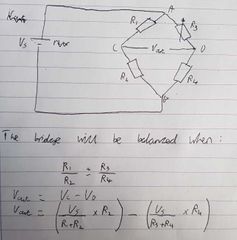
|
|
|
How to you add temperature compensation to a circuit? |
You can either use more than one transducer or u can use dummy leads connected in series with the opposite resistor to the transducer. This means that any changes temperature, changes the resistance of both sides of the bridge meaning that it doesn't have any impact on the output voltage |
|
|
What is the configuration for a ramp ADC? |
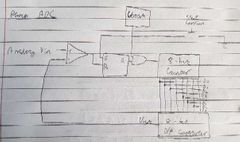
|
|
|
How does a ramp ADC work? |
Once the start conversion signal is received, the comparator compares the analog input voltage to the output of the DAC which is initially zero. The start conversion signal sets the SR flip flop output which is then fed into the input of an AND gate. The other input to the AND gate is a cloak oscillator. These components create a pulse which is recieved by the 8-bit counter. This counter then increments a binary count. The binary count is then converted back to an analogue signal by the DAC. This signal is then fed back into the comparator. If the positive input remains larger then, it will continue to emit a positive output which means that the SR flip flop will remain on and the cycle will continue. Once the inverting input becomes greater, the output of the comparator will become negative which will stop the SR flip flop and the count represented on the digital lines will be the final converted signal |
|
|
What is the main advantage and disadvantage of a ramp ADC? |
It's relatively cheap but has a slow conversion rate > 1ms |
|
|
What is the configuration for a flash ADC? |
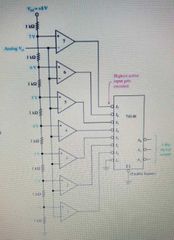
|
|
|
How does a flash ADC work? |
V ref is a stable reference voltage as Vin exceeds the reference voltage at each comparator the outputs of each comparator will saturate sequentially to a high state. The priority encoder generates a binary number based on the highest order active input. This means that if there's a high priority input or other lower priority inputs will be ignored |
|
|
What are the advantages and disadvantages of a flash ADC? |
It's faster then other methods but it requires a lot of comparators. Number of comparators needed equals 2^n-1 which means for a 8 bit output you would need 255 comparators |
|
|
What are the advantages and disadvantages of using a weighted resistor DAC? |
Uses less components but you need large and small resistors if you have a lot of bits to convert. This is a problem because each resistor reduces the accuracy of the system since a larger resistor has a much larger error than a smaller one |
|
|
What are the advantages and disadvantages of a R-2R ladder network DAC? |
Only two values of resistors are used which makes it better for higher accuracy applications but it uses more resistors |
|
|
What's BCD? |
Binary Coded decimal. It uses 4 bits to display or hold 0-9. Each digit of a decimal number is displayed using 4 bits |
|
|
What is the main advantage of BCD? |
It allows for easy conversion between decimal and binary form |
|
|
What is the main disadvantage of BCD? |
It's wasteful since the states between 10 and 15 aren't used |
|
|
Why are industrial networks used? |
1. Allow for easy transfer of data and information 2. Allow you to control a system with DCS 3. Fast data speeds for real time control 4. You can link the plant to a SCADA system 5. It allows you to use digital comms for noise immunity |

